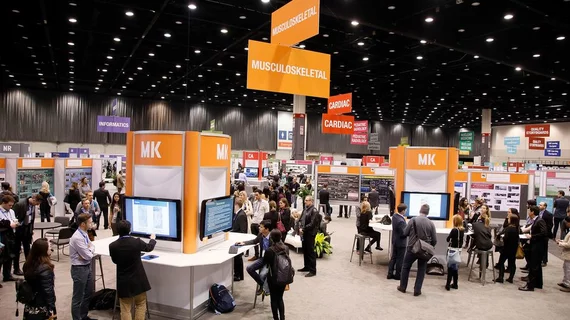Taken by the numbers, the population at RSNA 2018 isn’t hard to get a handle on. The total headcount is likely to again top 50,000. More than 700 exhibitors are showcasing their offerings. And a pre-show survey conducted by Paragon Consulting Partners showed the largest three attendee cohorts, as identified by job title, to be radiology administrators (29.3 percent), technologists (19.5 percent) and radiologists (17.7 percent).
The same survey showed attendees reported attending for three main reasons: to attend sessions/obtain CME credits (33.7 percent), visit the technical exhibits (31.4 percent) and network with leaders, peers and colleagues (20.9 percent).
That’s all interesting enough, but numbers don’t talk. People do. So Radiology Business roamed the show and asked a handful of attendees, one at a time, what brought them here and what takeaways they hoped to go home with. Here’s what we heard.
“The main thing I came to see is innovation. And for me personally, I’m here for the lectures focusing on artificial intelligence (AI), quality improvement and [radiation] dose reduction.” So said Lorette de Vries, a clinical physical assistant attending with a group from the radiology department at Reinier de Graaf Hospital in Delft, Netherlands.
De Vries said her group, which includes a radiologist, two physicists, two nuke-med people and the facility manager, had meetings lined up with vendors showing stents, PACS and SPECT-CT equipment. They also traveled here to learn about AI, and de Vries said they hadn’t been disappointed. “We’ve seen AI applied not only to helping with clinical diagnostics but also to optimizing workflow.”
Justin Clark, MD, a radiologist at the Captain James A. Lovell Federal Health Care Center in Chicago, is only a few miles from his workplace, but light years from his surroundings of a few weeks ago. A lieutenant commander in the U.S. Navy, he recently returned from a deployment to Afghanistan.
“I’m trying to learn a lot of the radiology that I got a little rusty on while I was deployed,” Clark told Radiology Business. “It’s always incredible to see and meet people from all across the world and to learn about the new developments in radiology as well as get a refresher on some areas that I need to focus on.”
Clark said he’s looking to catch up on some CME credits and visit the exhibit halls. “I’ve looked at automated breast ultrasound, as we’re looking to improve our workflow in mammography,” he said. “I looked at a portable radiography system for use overseas with the military. And I looked at some leaded [protective] eyeglasses for myself. So I guess I’m here for a little bit of everything.”
This is the second RSNA for Daniel Paech, MD, MSc, a radiology resident and researcher at the German Cancer Research Center in Heidelberg. He said his current research focuses on ultra-high-field scanners and he’ll be sharing notes with other people working with 7T MRI systems.
How high can high-field MRI go? “People intend to go to 14 Tesla whole-body scanners for humans,” Paech said. “But it will be a big step for the FDA to clear the 7 Tesla for [many indications]. Unfortunately, ours doesn’t have this clearance. We had a prototype almost 10 years ago. But with the FDA clearance of the 7 Tesla, cohort sizes of 7 Tesla studies will increase, and we will finally get to know what is the potential additional value of ultra high-field MRI.”
Waiting for a course to begin on emerging technologies in neuroradiology was Abhi Jain, a third-year medical student at Philadelphia College of Osteopathic Medicine. He said he’s not especially interested in the content of the educational sessions “because I’m going to forget it by two years down the road, when I start my residency. What I’m really interested in is networking with people—meeting [residency] program directors, talk about my interest in their program.”
Jain added that he’s also here to explore the nonclinical side of radiology. “I’m interested in seeing 3D printing, AI, imaging informatics,” he said. “I want to get basic information about those kinds of things and hear about how they’re going to impact radiology.”
Miranda Wilson-Wood, content development manager for the British Institute of Radiology, which publishes the British Journal of Radiology and others, said she crossed the Atlantic primarily in search of ideas for commissioning articles.
“I’ve got a few meetings set up, and I’ll be speaking with a number of presenters as well to hear about ongoing research projects and get feedback from the radiology community on our publications,” Wilson-Wood said.
She surely spoke for many if not most attendees when she noted that “probably 80 to 90 percent” of everything she’s heard has had to do with machine learning.
“The focus on AI in the president’s opening address was really interesting, looking at how to embrace AI rather than fear it,” Wilson-Wood said. “Dr. Rao gave some really interesting perspective on how to incorporate AI into clinical practice for the benefit of the patient.”

